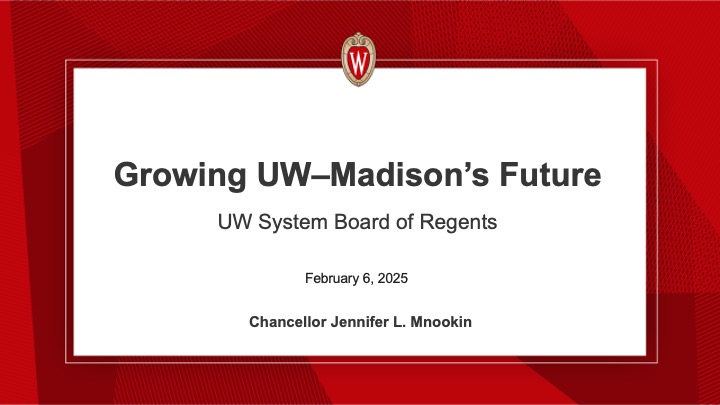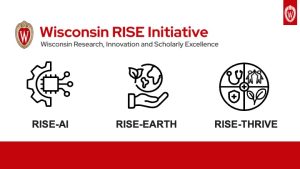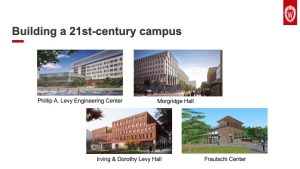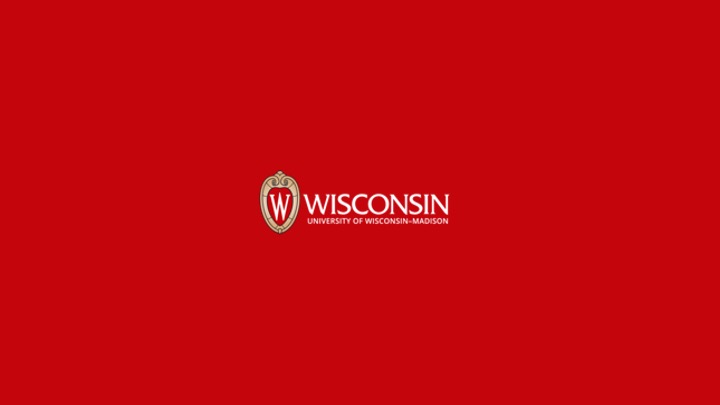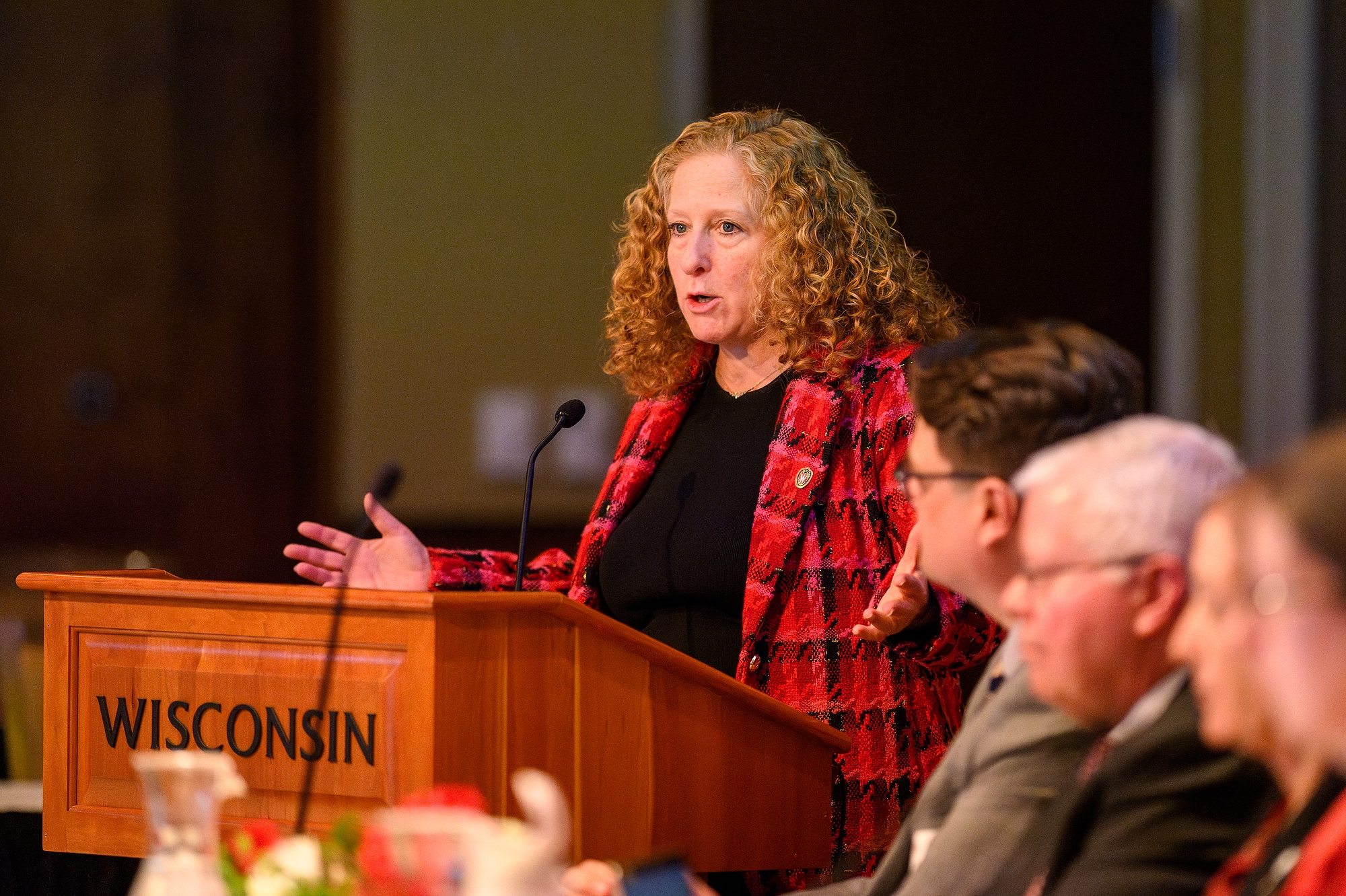
On Feb. 6, 2025, University of Wisconsin–Madison Chancellor Jennifer Mnookin addressed the Universities of Wisconsin Board of Regents. In a talk titled, “Growing UW–Madison’s Future,” Mnookin shared highlights from 2024, acknowledged the uncertainties facing higher education, and shared her vision for growing the university’s contributions to its students, Wisconsin and the world.
Good afternoon. I want to thank all of you, along with President Rothman, for your steady leadership and support in what is, by any measure, a somewhat challenging time for higher education.
Here at UW–Madison, it’s been a year of both incredible accomplishment and significant challenge. We have much to be proud of, and I will share some highlights. At the same time, as we look forward, there are substantial uncertainties and some dark clouds on the horizon, and I will speak of some of those as well.
But let me begin with a brief story.
Last fall, we hosted nearly 600 people in this space — dedicated alumni, campus leaders, and students who got to hear from the amazing John and Tashia Morgridge, who shared with us a time-tested principle they aim to live by: Plant trees under whose shade you do not expect to sit.
A wonderful metaphor that captures not only the Morgridges’ legacy of extraordinary generosity here at UW and throughout the state, but also something important about what this university contributes to Wisconsin and the world.
And it reminds us in challenging times in particular: Even as we manage day-to-day challenges, we have to be playing the long game.
Just last month, we began the process of creating a new strategic framework for the university’s next chapter, to help keep us planting the right trees at the right times in the right places.
But we’re not waiting for a full plan in order to lay the groundwork for success. So, in addition to talking about the challenges we’re facing, I’m also going to talk about some of the trees we’re planting.
Some will grow more slowly than others and need more nourishment, but all are critical to building long-term strength.
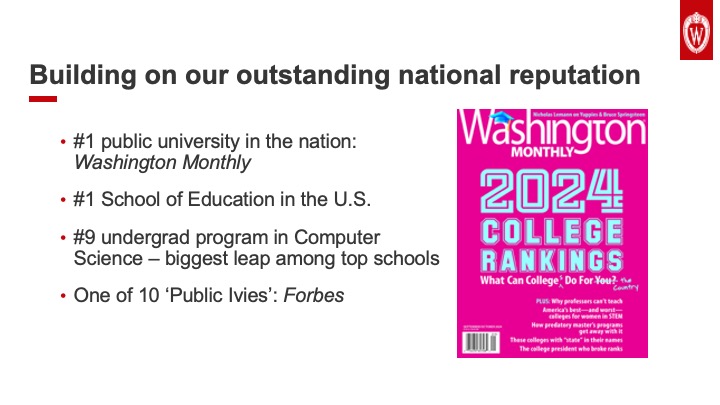 First, a few words of gratitude.
First, a few words of gratitude.
This year, with your help and the dedicated commitment of our truly outstanding faculty and staff, we’ve continued to build our already outstanding national reputation. A few highlights:
- No. 1 public university: Washington Monthly. I always will tell you to take rankings with grain of salt, and that holds for this one too. But, I will note that we particularly like this ranking not only because we did well, but because it’s based on contribution to the public good, including the social mobility of our graduates.
- No. 1 School of Education in the country
- In addition, our undergraduate program in computer science jumped six spots to No. 9 among publics (No. 16 overall) in the U.S. News rankings. The biggest leap among the top 25 schools.
- And last spring, Forbes included UW–Madison on its list of 10 ‘Public Ivies.’
By many reputational measures, 2024 was a very good year!
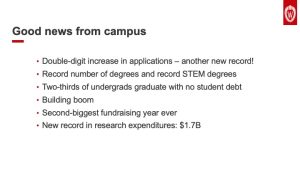 I’ve just gotten word that we’ve again set a new record for undergraduate applications. We’ve had a double-digit percentage increase over last year’s record, breaking 70,000. I can’t yet reveal the precise total as we’re still finalizing the figures, but a shout out to our admissions team who had to read well over 140,000 student essays this season.
I’ve just gotten word that we’ve again set a new record for undergraduate applications. We’ve had a double-digit percentage increase over last year’s record, breaking 70,000. I can’t yet reveal the precise total as we’re still finalizing the figures, but a shout out to our admissions team who had to read well over 140,000 student essays this season.
We also conferred a record number of degrees and a record number of degrees in STEM fields. And, thanks to programs like Bucky’s Pell Pathway and Bucky’s Tuition Promise, two-thirds of our undergraduates graduated with zero student debt.
We’re also in something of a building boom. Some of you donned hard hats to see one of our amazing new facilities yesterday, and I’ll tell you about a few others.
And, our friends and supporters are investing in us. Last year was the second-biggest fundraising year in our history, and we’re going to work hard to keep that momentum going.
It was also the year in which the state of Wisconsin won millions of dollars in federal funding as a Phase 2 tech hub, with UW–Madison and the Universities of Wisconsin as key partners, to build our national leadership in biohealth and personalized medicine.
And we at UW–Madison set a new record for research expenditures, moving from $1.3 billion in 2019 to $1.7 billion in 2023, announced last November.
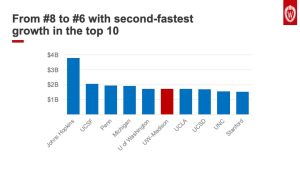 As you know, this growth allowed us to meet the goal of moving up in the HERD research expenditure rankings from No. 8 to No. 6.
As you know, this growth allowed us to meet the goal of moving up in the HERD research expenditure rankings from No. 8 to No. 6.
Our growth rate was second only to UNC among the top 10. There’s very little daylight between us, and No. 5 right above us, as well as No. 7 and No. 8, below. These numbers can of course fluctuate, as we know. But still, we were pleased to flip over both UCLA and UCSD.
We do not know at this point how the new administration’s policies might affect these federal grants going forward, though we can assume that there may well be a loss, and perhaps a substantial loss of federal dollars.
Which brings me to the federal transition, which poses quite significant threats to some important aspects of our mission and operations — as is true for universities across the nation.
Challenges and Uncertainties
I will focus on one aspect of the federal transition: the risks and uncertainties to our research mission. A quick summary of where we are:
The federal Office of Management and Budget issued a memo on Jan. 27 directing federal agencies to pause most financial assistance — including the federal grant funding that makes most of our research possible — while they review programs receiving federal dollars to assess their alignment with the President’s priorities and compliance with his executive orders.
This was part of a flurry of executive orders and directives relevant to federal funding across the board, including to higher education, with a particular focus on anything linked to DEI, apparently broadly construed but also undefined, or to climate change.
The speed and breadth and quantity of these developments has been, well, dramatic, to say the least.
For those few days, we at UW–Madison received a number of “stop work” orders on specific grants, as well as some broader orders from several agencies, including NSF, the National Science Foundation, to assess whether our grant work complied with the executive orders. And these orders contained absolutely no definitions of critical terms, including what exactly did or didn’t count as DEI or what would or would not be seen as part of the so-called green new deal.
Then, last Friday, a federal judge issued a temporary restraining order that formally paused the freeze on spending, providing what amounts to at least a temporary reprieve.
But, whatever happens with the executive orders of those first few days, the real point is that there is significant risk for federal research funding going forward.
We may see a disconcerting clawback of some awarded awarded but unspent grant funding, especially in areas linked to DEI and sustainability. We will almost certainly see some significant shifts in funding priorities going forward. That, of course, is not unexpected with a new administration, but it may well be more dramatic than has been typical over the last decades, even when there were changes in party. And it seems possible, indeed I fear it may be likely, that we will see significant overall cuts to federal science and research funding.
And any or all these changes will undoubtedly have an significant and deleterious impact on us here at UW–Madison. For our research enterprise, this could mean a potential loss of many tens or possibly even hundreds of millions of federal dollars.
Federal grants are our single largest source of revenue here at UW–Madison; they make up 25% of our total funding, and they fuel a good deal of our world-class research we do to innovate for the public good.
Across our institution, we spend $18.8 million every week, on average, on federally funded research. This is the lifeblood of cancer research to develop better treatments and move us closer to cures; biomedical research to engineer new therapies for disorders like Diabetes and Alzheimer’s disease; agricultural research to help Wisconsin farmers produce high-quality fruits and vegetables and meats and dairy products that feed not only our state but the entire nation and beyond; and research on renewable energies to help us build a more sustainable planet, to name just a few of the areas that this research supports.
All of these, and more, are at potential risk. More broadly, if agencies like the NSF and NIH face significant staffing and funding reductions, our collective research and innovation ecosystem, long a source of envy and admiration across the globe, could be deeply destabilized, all across the country, including for us at UW–Madison.
To be clear, at this moment, this is a serious risk but not a certainty. But part of the challenge of the moment is the degree of uncertainty we are facing.
I have directed a working group on emerging federal issues — a team of experts here and in D.C. — to track and assess relevant changes. And we’re also working with the System as we assess what’s coming.
Our responsibility, over the weeks and months ahead, will be to ensure we’re taking appropriate actions to comply with federal laws and directives while also preserving our mission and, simultaneously, staying true to our core commitments, including our commitments to evidence-based research; to freedom of speech and academic freedom; to fearless sifting and winnowing; and to supporting fairness, opportunity, and the respect for the human dignity of all members of our community.
In the short term, we’ve asked faculty and staff on federally funded projects to continue their important work (unless they receive a stop work order, with which they must comply) but to be cautious about making new commitments with federal funds given the substantial uncertainties we face.
But, our other responsibility is to continue to do all in our power to plant those trees for the future, even amidst challenges and uncertainties. So, in the rest of my time with you, I will talk about three such trees.
Three trees
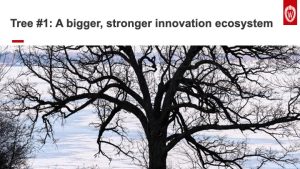 The first tree: growing a bigger, stronger research and innovation ecosystem fueled by cross-disciplinary collaboration. This is the secret sauce of RISE, which I announced here one year ago.
The first tree: growing a bigger, stronger research and innovation ecosystem fueled by cross-disciplinary collaboration. This is the secret sauce of RISE, which I announced here one year ago.
That’s our campuswide initiative to look at grand challenges facing Wisconsin and the world and grow the faculty in a targeted way that builds upon our existing strengths to create new opportunities for our students and accelerate discovery.
When we met here last year, we had one RISE initiative, RISE-AI, to expand our already excellent work in a space with tremendous possibilities and tremendous concerns.
We now have three: RISE-AI, RISE-EARTH (broadly focused on sustainability), and RISE-THRIVE (broadly focused on healthspan — how we help people live not just longer lives, but better lives).
They’re already generating some really exciting new collaborations among faculty who might not have worked together in the past — and inviting a more strategic way of thinking about opportunities to build on areas, including where we’re already strong.
As an example:
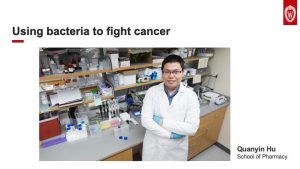 Faculty at our School of Pharmacy and School of Medicine and Public Health are collaborating on groundbreaking work on pancreatic cancer.
Faculty at our School of Pharmacy and School of Medicine and Public Health are collaborating on groundbreaking work on pancreatic cancer.
One of the reasons the survival rate for this cancer is so low is that we don’t have a good way to break through the dense matrix of connective tissue that surrounds these tumors. It’s actually a barrier to using the kinds of immunotherapies that are so promising against other cancers.
So, our researchers are using a strain of E. coli that’s particularly good at slipping through this protective cage, and they’re using it to deliver nanodrugs to target the cancer.
It’s very early — potential human clinical trials are still some time away — but in trials with mice, the drugs are delivered to the right spot, and they’re delaying tumor growth and significantly extending survival.
Just one example of the exciting interdisciplinary work that’s happening here, and that initiatives like RISE-THRIVE are going to let us build out further.
And one more — this one is a crossover between RISE-AI and RISE-THRIVE.
Faculty in radiology and biomedical engineering are using AI to examine enormous numbers of medical images of glioblastomas, which are lethal brain tumors that are especially aggressive in men, and that act very differently in women and men.
They’re using their findings to create a new tool to identify the unique characteristics of each patient’s tumor to help oncologists determine the best treatment options.
At the same time, we have faculty in biostatistics and medical informatics looking closely at the limits of AI in medicine and developing statistical methods that can help us avoid some of the problems that algorithms can introduce when they’re making inferences based on incomplete information.
So, we’re both pushing the boundaries of personalized, precision medicine and paying close attention to the potential pitfalls of AI: sifting and winnowing at the frontiers of advanced genomics.
When we launched RISE here one year ago, we’d not yet made a single hire.
Today, we have 30 new RISE faculty on campus and an additional 15 committed for next year, and that number is growing every month, all across our institution, from our School of Engineering to SOHE, from L&S to the Law School, as we build toward the goal of 120-150 new hires above and beyond our normal faculty hiring to propel this initiative forward.
A year ago, I heard from some people who said, “This won’t work. We don’t really have the infrastructure to support an initiative of this magnitude.” To which I said, “Let’s try anyway.”
Indeed, RISE is compelling us to look with fresh eyes at our infrastructure and services. We’re identifying gaps we need to fill as well as synergies with non-RISE projects, including the campuswide Sustainability Initiative that I told you about last year to address the environmental impact of our campus.
For the first time, we have set specific targets for the first time and identifying new ways to weave sustainability into the curriculum.
One quick example you might have walked past on your way in this morning:
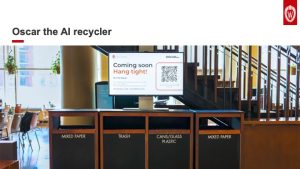 This is Oscar (named for Oscar the Grouch), a new AI recycler we’re piloting. You might have walked past him on your way up. He’s a key player in helping us reach our goal of zero waste by 2040.
This is Oscar (named for Oscar the Grouch), a new AI recycler we’re piloting. You might have walked past him on your way up. He’s a key player in helping us reach our goal of zero waste by 2040.
He’s not quite operational yet, but soon he’ll be able to scan an item you’re holding and tell you where to put it. If you put it in the wrong place, Oscar will turn red.
In a very ‘UW’ way, the faculty are already weaving Oscar into research and class projects. For example, in experiments to test whether people are more motivated to recycle properly by an interaction like a dancing badger popping up on the screen or by an incentive to maybe get a gift card if you’re lucky. Stay tuned!
Oscar is just one part of our much larger Sustainability Initiative.
The big picture is this: We have three initiatives – RISE, Sustainability, and our Entrepreneurship Initiative (which I’ll tell you about in a moment), that are adding to a flywheel effect.
Our culture draws great people here. They work with outstanding current faculty to push the institution forward. And that draws more great minds here to Wisconsin, who accelerate discovery and ultimately fuel the state’s economy.
It’s a win-win-win — and it’s the Wisconsin Idea in action.
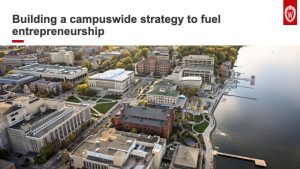 I told you last year about the all-star team I’d appointed to study how we might chart a new direction that fully embraces entrepreneurship as central to our Wisconsin Idea mission. The goal is to make UW–Madison a premier institution for people who want to pursue entrepreneurship. This is another area where we have opportunities to magnify our already tremendous economic impact on Wisconsin and move life-changing innovations out into the world.
I told you last year about the all-star team I’d appointed to study how we might chart a new direction that fully embraces entrepreneurship as central to our Wisconsin Idea mission. The goal is to make UW–Madison a premier institution for people who want to pursue entrepreneurship. This is another area where we have opportunities to magnify our already tremendous economic impact on Wisconsin and move life-changing innovations out into the world.
The committee’s final report is like the Google Earth 360-degree view. Now, it’s our job to zoom into “street view” and determine the best way forward, to make our strong entrepreneurship ecosystem even better and more impactful.
You’ll hear much more from the terrific panel tomorrow morning that includes entrepreneurs along with Erik Iverson, CEO of WARF. WSB Professor Jon Eckhardt will lead off with an overview of the committee’s report. I’m pleased to say that Jon — whose area of scholarship is entrepreneurship — is now serving as a one-year special advisor working closely with me and with a wide array of stakeholders to build out this initiative.
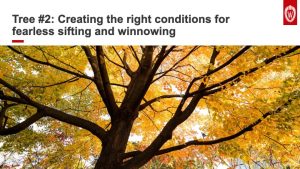 One of the things I value deeply about big, complicated universities like ours is their wonderful plurality. There are very few places on earth where so many different ways of seeing the world from different disciplines and different perspectives come together in an intentional way. That can be cacophonous at times, but it’s also necessary for the kind of sifting and winnowing that sparks new ways of thinking about problems.
One of the things I value deeply about big, complicated universities like ours is their wonderful plurality. There are very few places on earth where so many different ways of seeing the world from different disciplines and different perspectives come together in an intentional way. That can be cacophonous at times, but it’s also necessary for the kind of sifting and winnowing that sparks new ways of thinking about problems.
Our university must be a place that welcomes all points of view and encourages diversity of thought as well as diversity of experience, identity, and background. And, it must be a place where people can meet one another with curiosity and respect and a willingness to listen even when they heartily disagree.
That’s challenging. And we’re always working — and we need to keep working — to improve the environment for speech and debate on campus. We’ve made progress with new policies on expressive activities and public statements designed to create more spaces, and more expectations, for engagement across our differences.
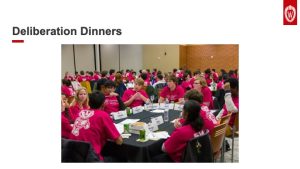 We’ve also doubled the size of our deliberation dinners I told you about last year, a project that helps students learn to have productive discussions about controversial issues. And which has been enormously well received by our students. I’ll get to attend another one later this month.
We’ve also doubled the size of our deliberation dinners I told you about last year, a project that helps students learn to have productive discussions about controversial issues. And which has been enormously well received by our students. I’ll get to attend another one later this month.
But I believe we need to do more in three areas:
First, it’s imperative that we regularly have a diversity of viewpoints on our campus — among students and faculty, as well as through invited talks, debates, conversations and opportunities for engagement. At the same time, it’s equally critical for us to make good on our promise that students of all backgrounds, beliefs and identities can thrive here. It’s a mistake to view diversity through just one or two lenses. Our pluralistic excellence requires all of these kinds of diversity.
Second, we have a responsibility to assess the significant investments we’ve made over many years in programs to support inclusive excellence and determine where they are working well and where they may be falling short. I have no magic wand, but it’s imperative as stewards of this great public university that we set goals and hold ourselves accountable and make changes when things aren’t working. We also have a responsibility to further our work on comprehensive outreach, to create opportunities for talented and hardworking students from all corners of our state, our nation, and the world.
And third, we need to do still more to prepare our students to become engaged and informed citizens of our complex and sometimes contentious democracy. Not to tell them what to think, but to help them strengthen their ability to work productively, disagree constructively, and even find common ground and work together on projects.
We have many examples of doing all of these things, both in our classrooms and beyond. But I would very much like to see us further grow these efforts. That’s something I hope we can shape and develop further in the year ahead.
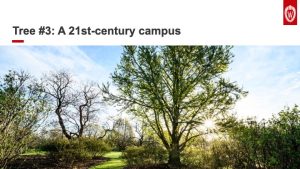 This brings me to the third tree: a modern, state-of-the-art campus that makes it possible for the other trees to thrive. We’ve had some major developments this year in that regard!
This brings me to the third tree: a modern, state-of-the-art campus that makes it possible for the other trees to thrive. We’ve had some major developments this year in that regard!
I’m so excited that Morgridge Hall is slated to open in time for the start of fall semester. It’s going to be a terrific space for learning, researching and collaborating. And those of you who got to see it on our tours yesterday, I think, would all agree.
Phillip A. Levy Engineering Center: We announced Marv & Jeff Levy’s incredibly generous $75 million gift in September, in honor of their late brother Phil, a proud alum who didn’t study engineering (none of Marv, Jeff and Phil were engineers) but recognized its importance as a driver of innovation and economic development. We’re grateful also to the legislature and executive branch for supporting this project. Demolition set to begin in April, hoping for completion in 2028. We’re still $35 million away from our $150 million goal.
Irving and Dorothy Levy Hall: Like the engineering building, this project is made possible with state funding, along with philanthropy and a generous leadership gift from Marv and Jeff Levy, this one in honor of their parents. It’s the first new academic building for any humanities departments within the College of Letters & Science in more than 50 years. We broke ground in May and hope for completion in 2026. This is part of effort to get us out of the Humanities Building. That is central to our budget request this year, and I very much appreciate the Universities of Wisconsin and Regents’ support for this project. We’re feeling the excitement among our alums and campus community to start re-imagining what that space might be.
The Frautschi Center will be a wonderful front door to the Lakeshore Nature Preserve and a living laboratory and classroom, and our first net-positive building on campus, meaning it will send energy to the power grid. We announced the Frautschis gift in July and hope to complete the new building in late 2026. Four generations of Frautschis hold degrees from this university, and one of the grandchildren is on campus right now. Like the Levys and the Morgridges, and like so many others, they believe deeply in our mission and have a real love for this campus. We are incredibly fortunate in that way.
Conclusion
I am incredibly honored to lead this amazing university. We have had a momentous year with a substantial number of achievements that are building on our excellence and setting the stage for a truly exciting next chapter.
I want to recognize these accomplishments even as I acknowledge that we’re operating in a very complicated world of:
- Significantly shifting federal priorities that could affect us in a variety of critical ways, some of which I discussed.
- A state budget process unfolding in a moment when we badly need the state to invest in all of the Universities of Wisconsin. As you’ve heard from President Rothman, the statewide system is 43rd out of the 50 states in state investment. We need a strong partnership with our state, and we need strong investment. I also want to acknowledge my fellow chancellors who are doing incredible work with limited budgets.
- And a moment in college athletics that’s both unsettled and unsettling, where the environment we operate in tomorrow will look quite different than yesterday. The Audit Committee heard from Mac this morning. And speaking of athletics, let’s give a cheer for our — once again — No. 1 ranked women’s hockey team having an amazing season!
And so to conclude: While there is much to cheer about — from women’s hockey to our record high application numbers and graduation rates — I fully grant that it is not an easy time for higher education. Not here in Wisconsin, not here at UW–Madison, and not anywhere.
But UW–Madison has been a jewel of our state for 175 incredible years, and I want the UW–Madison of seven years from now – of 17 years from now — and yes, the UW–Madison of 176 years from now, to be even stronger than it is today.
And so, I dare to hope that some of the trees that we work together to plant today and tomorrow will indeed help make that future possible.
Thank you all, and On, Wisconsin.
